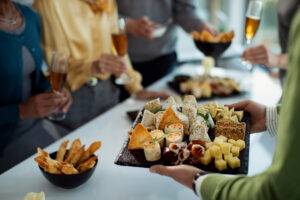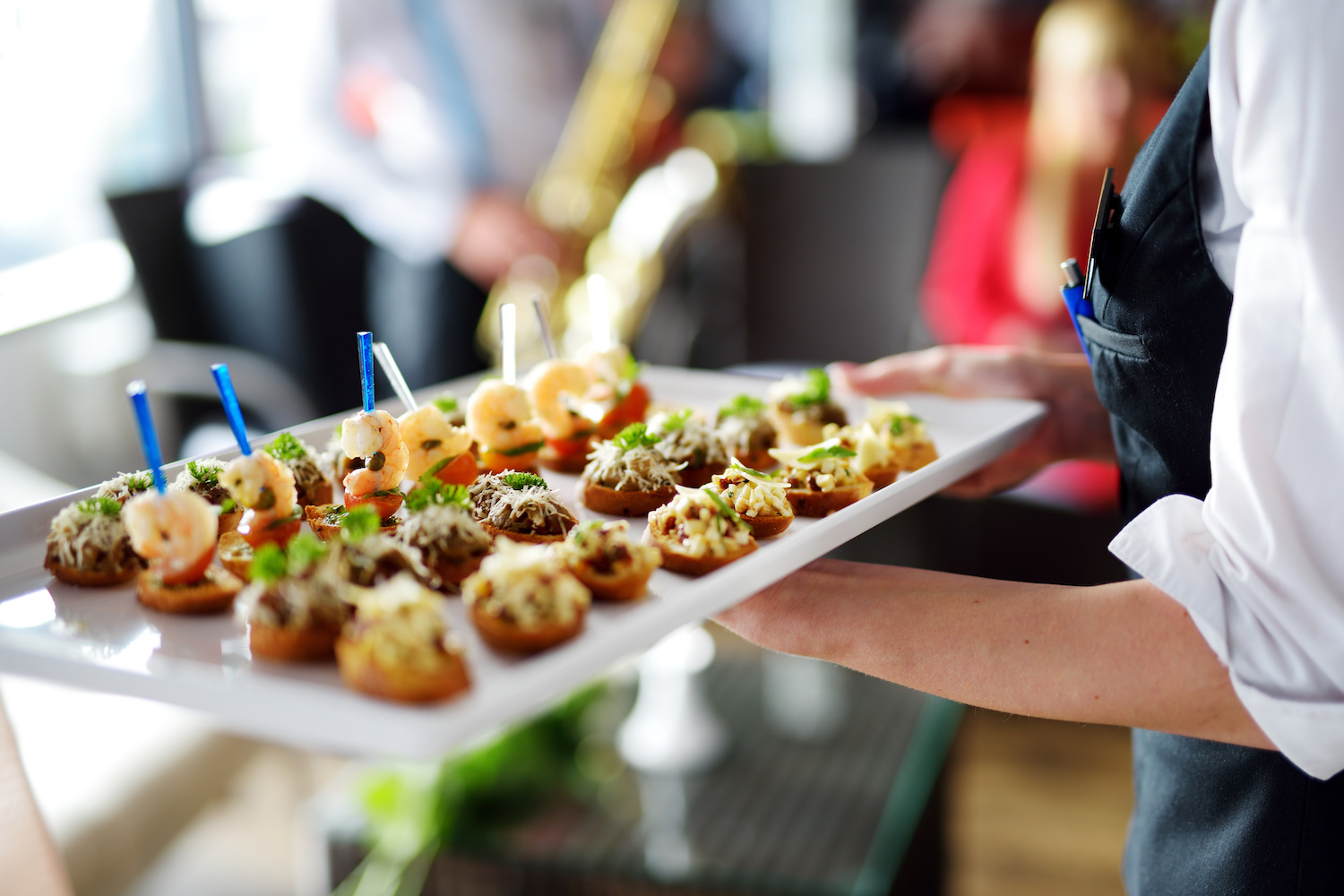Are you thinking about planning a networking event or party in 2024? Whether you’re looking to connect professionals, foster business relationships, or just bring people together for a good time, knowing how to organize a successful networking event is key. In this guide, we’ll show you the steps to plan a networking party that’s memorable and effective. From setting clear goals to choosing the right foods that make mingling easy, we’ll cover everything you need to make your event a hit. This guide is focused on what makes networking events special, so you’ll get all the details you need to host an amazing gathering.
1. Establish a Clear Purpose for Your Networking Event
Define Your Objectives Clearly
Begin by writing down your main objectives. Are you focusing on fostering new business partnerships, offering a platform for idea exchange, or perhaps helping recent graduates find job opportunities? Having a clear list of objectives will guide every other aspect of your planning process.
Identify Your Target Audience
Think about who should come to your event and what you want them to get out of it. Tailor your event to the needs of your audience. For example, if your goal is to help startups find investors, you’ll want to invite successful entrepreneurs, venture capitalists, and perhaps even financial advisors.
Set Measurable Goals
For each objective, set measurable goals. This could be the number of connections you hope attendees will make, specific feedback you want on new products or the number of follow-up meetings that should be set. Measurable goals will help you evaluate the success of your event afterward.
Plan Your Content
Based on your objectives and audience, plan what content will be most beneficial. If you connect job seekers with companies, consider setting up resume review stations or quick interview rounds. For a business owner meetup, think about having expert talks on relevant topics like market trends or funding opportunities.
Create an Engaging Theme
Sometimes, a unifying theme can make your event more engaging and memorable. If your event aims to connect tech innovators, a theme like “The Future of Technology” could set the right tone and attract the right participants.
Communicate the Purpose
When promoting your event, be clear about its purpose. This isn’t just about attracting attendees; it’s about attracting the right ones. Your invitations, advertisements, and even your event’s homepage should clearly state what attendees will gain from participating, whether it’s insight, contacts, or opportunities.

2. Choose a Format for Your Networking Event
Selecting the right format for your networking event is key to making it effective and engaging. The format you choose should match the goals you’ve set and cater to the preferences of your target audience. Here’s how you can pick the best format for your networking event:
Consider Your Audience
Begin by profiling your expected attendees. What industries do they come from? What are their professional levels? What might they be seeking from your event—new contacts, specific information, potential job opportunities? Use this information to plan the format of your event. For instance, young tech entrepreneurs might prefer a less formal, more interactive event with technology integrations, while finance professionals may value structured interactions and speeches from industry leaders.
But how can you find out what people will want to do at a networking event? Here’s a few ways to get a pulse on your target audience:
- Pre-Event Surveys: Send out surveys or questionnaires to potential attendees during the registration process. Ask about their goals for attending, topics of interest, preferred types of sessions (e.g., workshops, panels), and any specific people or companies they hope to connect with.
- Engage on Social Media: Use social media platforms where your target audience is active to ask questions about what they look for in networking events. This can be done through polls, direct posts, or by joining relevant groups and discussions.
- Social Proof: Check testimonials and reviews of similar events to gather data on what participants found beneficial.
By using these methods, you can learn a lot about what your audience hopes to get from networking events. This knowledge will help you create an event that doesn’t just meet their needs, but goes beyond what they expect, making it an event they won’t want to miss.
Decide on the Scale
The number of attendees will significantly affect your choice of format. A large event with hundreds of attendees might be overwhelming without structured networking opportunities like speed networking sessions, whereas a smaller group might benefit from a single, open space that encourages mingling. Here is a breakdown of the best format for different sizes of networking events:
Small-Scale Networking Events (10-50 Attendees)
Smaller events allow for deeper, more meaningful conversations. Attendees can get to know each other better, which is great for building strong professional relationships. If you plan a networking event of this size, roundtable discussions, workshops, and small group dinners or cocktail hours work well. These settings encourage everyone to participate and share. In this case, it is best to choose a cozy, inviting space that encourages mingling, such as a private dining room or a small gallery. For activities, plan activities that involve everyone, like a group brainstorming session or a collective problem-solving activity!
Medium-Scale Events (50-200 Attendees)
These events are large enough to offer diverse networking opportunities but they are still manageable for meaningful engagement. For medium-scale events, panel discussions followed by breakout sessions, speed networking events, or industry-specific meetups can be effective. Because you are hosting more people for this size of networking event, select a venue that can comfortably accommodate different activities, like a conference center with multiple breakout rooms. Organize structured networking activities and provide free time for open networking to balance the structured with the casual.
Large-Scale Events (200+ Attendees)
Large events can attract a broad audience, which is beneficial for expanding professional networks and showcasing influential speakers. Keynote speeches, large panels, and expos are suitable for large gatherings like these. Structured networking sessions, like scheduled meet-ups or themed networking zones, can help manage interactions. When it comes to large networking events, ensure the venue can handle large crowds comfortably, with ample space for different types of interactions, including lounges and exhibition areas. Implement technology solutions like mobile apps for scheduling, maps, and networking to help attendees navigate the event and connect effectively.
Universal Considerations
- Regardless of size, it’s important to remain flexible. Be prepared to adjust the format based on real-time feedback and participation levels during the event.
- Tailor activities and interactions to fit the scale of your event. Smaller events may benefit from more personalized touches, while larger events might need more structured and broad-reaching activities.
- Use technology to enhance the networking experience. For larger events, technology like event apps that help manage schedules, facilitate introductions, and encourage participation are particularly useful.

3. Plan for Interaction
Designing your networking event to maximize interaction among attendees is key to its success. Effective interaction helps foster meaningful connections and ensures that your guests leave with valuable contacts and insights. Here’s how to plan for robust interaction at your networking event:
Structured Networking Activities
- Speed Networking: Organize speed networking sessions where attendees rotate and have brief, timed conversations with each other. This format ensures that everyone meets many different people quickly.
- Themed Discussion Tables: Set up tables or areas dedicated to specific topics or industries. Attendees can choose which table to join based on their interests or expertise, facilitating more relevant and engaging conversations.
Icebreakers and Social Games
- Icebreaker Questions: Start the event or sessions with fun icebreaker questions that encourage people to share personal or professional stories. This can help warm up the crowd and make subsequent interactions more comfortable.
- Networking Bingo: Create a bingo game where attendees have to find others who meet certain criteria (e.g., has started their own business, has worked internationally). This game encourages guests to mingle and playfully learn about each other.
Facilitated Introductions
- Role of Facilitators: Have facilitators or hosts who actively introduce people to each other based on their interests and professional goals. This can be particularly helpful in larger events where attendees might feel overwhelmed by the number of people.
- Connection Corners: Designate areas where attendees can go if they are interested in being introduced to someone new. Facilitators can help by matching attendees with similar interests or complementary professional goals.

Best Foods for Networking Events
Choosing the right food can significantly enhance the networking experience by encouraging guests to interact and mingle. Here are some tips on how to select food that facilitates conversation and connection at a networking event.
Consider the Time of Day
It’s important to think about what time your event will happen because this will help you decide what kind of food to serve.
Is your event during a mealtime? If “yes,” guests will likely arrive very hungry. In this case, make sure to offer some heartier foods that will fill them up.
Will the event be a happy hour event? If so, you may have a signature drink in mind (often these go with an event theme) so you can use the food to complement the drink. For example, a Mexican Fiesta serving margaritas may decide to serve mini tacos, quesadillas, or ceviche.
Will the event be mid-morning or afternoon? If so, consider pick-me-up snacks such as soft pretzels, energy bars, sugary cookies, or chocolate.
Keep Seating in Mind
The next question you should ask is: Will there be seating?

If the answer is “Yes”:
Seating is usually limited at networking events because it can keep guests from moving around and mingling. However, if seating is necessary for part of your event, you can offer a wider variety of foods, including more complex dishes that can be served as a plated meal. If your networking event includes seated tables, consider having a buffet. This encourages guests to get up from their chairs and talk to others. Another idea is to start with an unseated happy hour followed by a sit-down meal, which also promotes mingling.

If the answer is “No”:
No seating is often preferred at networking events because it allows guests to move around freely, meet more people, and engage in conversations. In this setup, it’s best to skip the plates and utensils. Guests might already be holding items like purses, laptops, and drinks, so plated food isn’t practical.
Opt for small passed appetizers or finger foods placed on tables that encourage grazing. The key is to select foods that are easy to handle and eat. Choose items that can be eaten in one or two small bites and won’t crumble or leave residues, like green specks between teeth. This ensures the food is portable, easy to manage, and helps maintain a clean smile.
If you decide to have food stations, also consider the shelf life of the foods served. Avoid anything that needs to be kept very hot or cold for a long time to stay fresh. This way, the food remains appealing and safe to eat throughout the event.
Even if you decide not to have any seating at your networking event, a few high cocktail tables scattered around the room are a good option. These give guests a place to put their drinks and a feeling of standing around a table which can create a “comfort zone.”
Tie the Food to a Theme
A great way to tie an event together is through the food. A camping theme may be emphasized with small skewers or s’mores. A Luau is a good chance to showcase pineapple or pork dishes. Mini hot dogs or cotton candy may work well with a carnival theme. Whatever your theme, make sure the food at least remotely ties back to the rest of the decor, entertainment and overall event backdrop.
Best Foods for Hosting a Networking Event
When planning a networking event, choosing the right food can make a big difference. Here are some top picks that are not only delicious but also easy to eat, allowing your guests to mingle comfortably:
- Mini Quiche: These small delights are perfect for networking events. They’re easy to grab and can be eaten in just one or two bites. Mini quiches come in various flavors, including vegetarian and gluten-free options, making them suitable for almost everyone. Plus, they can be served warm or cold, giving you flexibility depending on your event setup.
- Mini Tacos: Perhaps it’s because I’m from Texas, but mini tacos are a crowd-pleaser. They’re quick to eat, can be filled with an array of ingredients, and pair wonderfully with fun cocktails like margaritas or mojitos. Don’t forget to try our favorite healthy-ish margarita recipe to complement them!
- Bruschetta: This versatile appetizer can be topped with anything from salmon and cream cheese to tomatoes and olives. These tasty little toasts are easy to handle and are just the right size for a couple of bites.
- Cocktail Meatballs: Bite-sized and packed with flavor, cocktail meatballs are a hit at any event. They’re particularly convenient when served on toothpicks, making them easy to handle as you chat.
- Foods on Toothpicks: Whether it’s cheese cubes, olives, or fruit, anything served on a toothpick is perfect for networking events. These items are typically one-bite size, mess-free, and easy to eat while holding a conversation.
These are just a few of my favorite options, but the possibilities are endless. When selecting foods, consider the theme, budget, and season of your event. Keeping our tips in mind for good networking event food will help you choose fantastic fare that enhances the social experience at your next gathering.















